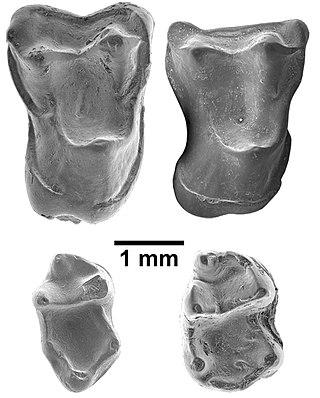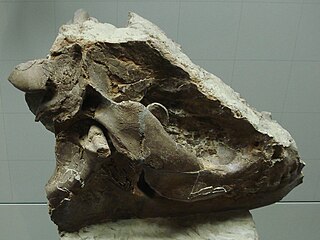
The simians, anthropoids, or higher primates are an infraorder of primates containing all animals traditionally called monkeys and apes. More precisely, they consist of the parvorders New World monkeys (Platyrrhini) and Catarrhini, the latter of which consists of the family Cercopithecidae and the superfamily Hominoidea.

Carcharhinus is the type genus of the family Carcharhinidae, the requiem sharks. One of 12 genera in its family, it contains over half of the species therein. It contains 35 extant and eight extinct species to date, with likely more species yet to be described.

Diatomyidae is a family of hystricomorph rodents. It is represented by a single living species, Laonastes aenigmamus, native to Laos in Southeast Asia. Fossil species are known from the Oligocene and Miocene of Asia and eastern Europe.

Eosimiidae is the possible family of extinct primates believed to be the earliest simians.

Herpetotheriidae is an extinct family of metatherians, closely related to marsupials. Species of this family are generally reconstructed as terrestrial, and are considered morphologically similar to modern opossums. Fossils of herpetotheriids come from North America, Asia, Europe, Africa, and perhaps South America. The oldest representative is Maastrichtidelphys from the latest Cretaceous (Maastrichtian) of the Netherlands and the youngest member is Amphiperatherium from the Middle Miocene of Europe. The group has been suggested to be paraphyletic, with an analysis of petrosal anatomy finding that North American Herpetotherium was more closely related to marsupials than the European Peratherium and Amphiperatherium.

Paraentelodon is an extinct entelodont from the Late Oligocene and Oligocene-Miocene boundary of Asia. The fossils of the type species P. intermedium were found in Georgia, Kazakhstan and China. An indeterminate species represents in Bugti Hills which is the late Oligocene of Pakistan.
The Divisaderan age is a South American land mammal age, covering a period of geologic time within the Middle and Late Eocene epochs of the Paleogene. It follows the Mustersan age and is followed by the Tinguirirican age.
The Deseadan age is a period of geologic time within the Oligocene epoch of the Paleogene to the Early Miocene epoch of the Neogene, used more specifically within the SALMA classification of South America. It follows the Tinguirirican and precedes the Colhuehuapian age.
Bugtilemur is an extinct genus of Strepsirhine primate belonging to the adapiform family Ekgmowechashalidae.It is represented by only one species, B. mathesoni, which was found in the Chitarwata Formation of Pakistan.
Phosphatosaurus is an extinct genus of dyrosaurid crocodylomorph. It existed during the early Eocene, with fossils having been found from North Africa in Tunisia and Mali. Named in 1955, Phosphatosaurus is a monotypic genus; the type species is P. gavialoides. A specimen has been discovered from Niger, but it cannot be classified at the species level.
Nalameryx is an extinct genus of tragulid which existed in lower Chitarwata Formation, Pakistan during the middle Oligocene. It was first named by Grégoire Métais, Jean-Loup Welcomme and Stéphane Ducrocq in 2009 and the type species is Nalameryx savagei. Nalameryx savagei is one of the rare mammals found during the Oligocene. Five dental remains composed the originally found material, described in 1990. The first phylogenetic hypothesis proposed Nalameryx to be closely related to the basal ruminant Lophiomerycidae. The description of new specimens from the type bed K/7b from the Kargil Formation, led to a reinterpretation of the phylogenetic position of Nalameryx and of the early evolutionary history of the Tragulidae. Based on the phylogenetic hypothesis, Nalameryx is nested within the living Tragulidae, making it one of the oldest known tragulid.
Dermotherium is a genus of fossil mammals closely related to the living colugos, a small group of gliding mammals from Southeast Asia. Two species are recognized: D. major from the Late Eocene of Thailand, based on a single fragment of the lower jaw, and D. chimaera from the Late Oligocene of Thailand, known from three fragments of the lower jaw and two isolated upper molars. In addition, a single isolated upper molar from the Early Oligocene of Pakistan has been tentatively assigned to D. chimaera. All sites where fossils of Dermotherium have been found were probably forested environments and the fossil species were probably forest dwellers like living colugos, but whether they had the gliding adaptations of the living species is unknown.

Afrasia djijidae is a fossil primate that lived in Myanmar approximately 37 million years ago, during the late middle Eocene. The only species in the genus Afrasia, it was a small primate, estimated to weigh around 100 grams (3.5 oz). Despite the significant geographic distance between them, Afrasia is thought to be closely related to Afrotarsius, an enigmatic fossil found in Libya and Egypt that dates to 38–39 million years ago. If this relationship is correct, it suggests that early simians dispersed from Asia to Africa during the middle Eocene and would add further support to the hypothesis that the first simians evolved in Asia, not Africa. Neither Afrasia nor Afrotarsius, which together form the family Afrotarsiidae, is considered ancestral to living simians, but they are part of a side branch or stem group known as eosimiiforms. Because they did not give rise to the stem simians that are known from the same deposits in Africa, early Asian simians are thought to have dispersed from Asia to Africa more than once prior to the late middle Eocene. Such dispersals from Asia to Africa also were seen around the same time in other mammalian groups, including hystricognathous rodents and anthracotheres.

Afrotarsius is a primate found in the Paleogene of Africa.
This paleomammalogy list records new fossil mammal taxa that were described during the year 2012, as well as notes other significant paleomammalogy discoveries and events which occurred during that year.

Mesaceratherium is an extinct genus of rhinoceros.
This paleomammalogy list records new fossil mammal taxa that were described during the year 2009, as well as notes other significant paleomammalogy discoveries and events which occurred during that year.
The Amphipithecidae were simian primates that lived in Late Eocene and Early Oligocene. Fossils have been found in Myanmar, Thailand, and Pakistan. The limited fossil evidence is consistent with, but not exclusive to, arboreal quadrupedalism. In other words, the species may have moved about in trees on four legs, but not with regular leaping as seen in later simians.
Bugtitherium is an extinct genus of anthracothere found in late Oligocene (Chattian) deposits in the Bugti Hills of Baluchistan, Pakistan.
The Agua de la Piedra Formation is a Late Oligocene geologic formation of the Malargüe Group that crops out in the southernmost Precordillera and northernmost Neuquén Basin in southern Mendoza Province, Argentina.









